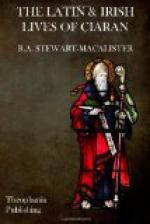Deacon Iustus, according to VTP (p. 104) and Tirechan’s Collections regarding Saint Patrick (edited in VTP, see pp. 305, 318) was consecrated by Saint Patrick, who left with him his ritual book and his office of baptism, in Fidarta (Fuerty, Co. Roscommon). It was in his old age that he baptized Ciaran, out of Patrick’s book—he was, indeed, according to the documents quoted, no less than 140 years of age. The glossators of the Martyrology of Oengus (Henry Bradshaw Society edition, p. 128) confuse him with Euthymius, the deacon, martyred at Alexandria. The play on words ("it were fitting that the just one should be baptized by a Just One”) is lost in the Irish version, whence Plummer (VSH, i, p. xlix) infers that this document is a translation from a Latin original: but the fact proves nothing more than that the author of VG borrowed this particular incident, as he borrowed his preface, from a Latin writing. All these Lives are patchworks, and their component elements are of very different origins and dates.
The date of Ciaran’s birth was 25 February, A.D. 515. The Annals of Ulster says 511, or “according to another book,” 516. The Annals of Clonmacnois has the correct date, 515.
The Geographical Names in this Incident.—Temoria (LA) is Tara (Irish Teamair), Co. Meath, the site of the dwelling of the Kings of Ireland. Midhe (LA) means the province of Meath; LA is, however, in error in placing the Latronenses therein. The Connachta are the people who give their name to the province of Connacht. Mag Ai, variously spelt, is the central plain of Co. Roscommon; Raith Cremthainn ("the fort of Cremthann”) was somewhere upon it, presumably near the royal establishment of Rathcroghan, but the exact site is unknown. Isel Chiarain (VG), a place reappearing later in the Life, is unknown, but doubtless it was close to Clonmacnois. Cluain maccu Nois, the “Meadow of the Descendants of Nos,” now Clonmacnois, stands on the right bank of the Shannon about twelve miles below Athlone. Extensive remains of the monastery founded by Ciaran are still to be seen there. As for Tech meic in tSaeir, “the house of the wright’s son,” we might have inferred that this place was also somewhere near or in Clonmacnois; but a note among the glosses of the Martyrology of Oengus (under 9th September) says that it was “in the house of the son of the wright” that Ciaran was brought up. It is therefore to be identified with the mysterious place corruptly spelt “Templevickinloyhe” (church of the son of the ——?) in the extract from the Annals of Clonmacnois printed above.[11]
The Verses in this Section of VG.—The epigram on Ciaran’s parents is found in many MSS. The rendering here given expresses the sense and reproduces the rhythm of the stanza, but does not attempt to copy the metre in every detail. This is known as cro cummaisc etir casbairdne ocus lethrannaigecht, and consists of seven-syllable lines with trisyllabic rhymes, alternating with five-syllable lines having monosyllabic rhymes. Literally translated the sense would run, “Darerca my mother / she was not a bad woman // Beoit the wright my father / of the Latharna of Molt.”




